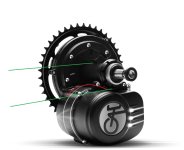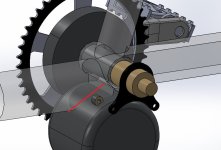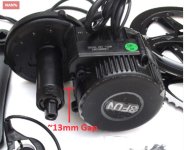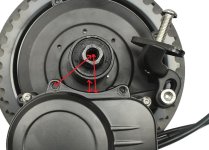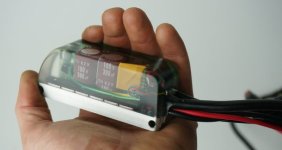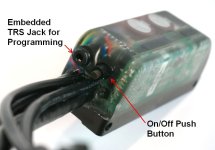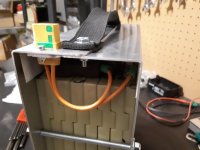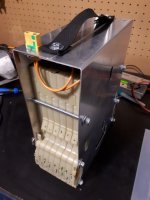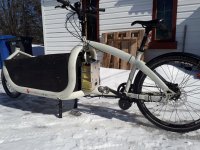fatty said:
amberwolf said:
FWIW, a hubmotor in the wheel has several disadvantages (though some advantages), including making the wheel weaker
I haven't seen this proposed before and it runs counter to conventional wisdom in non-motor wheels, such that wide and tall spoke flanges result in a stronger wheel than narrow and low flanges. Hubmotor flanges aren't especially wide, but they sure are tall. They're also built with more and thicker spokes. Longer spokes have proportionately longer elastic and plastic deformation, but that's insignificant compared to geometry and spoke count and gauge.
Can you explain?
I probably should specify "OEM hubmotor wheels" because those are not usually built correctly or with parts that should be used together, but even well-built hubmotor wheels can be weaker than the same wheel with a regular-sized hub in it. And probably should also specify that the larger diameter the hub is, the more the problems tend to stand out; the closer the hub is to the more typical size used, the less the problems tend to crop up.
As far as the spokes go, AFAICT it depends on the resulting bracing angle of the spokes, and the usage of the wheel. If it's a wheel that won't see much sideloading (like most bicycle wheels, because you lean in turns) then even that may not make much difference. If it's a trike, with no leaning mechanism, the angle may make a significant difference to how strong the wheel is, because every turn will create significant sideloading from the tire to the rim across the spokes to the hub, on all three wheels. (I ran into this problem on both of my trike builds so far, even with regular bike wheels, and with all of my trailers, but almost never with any of my bikes).
The length of the spokes makes some difference too, as does the spoke thickness and rim type (though making sure each of those is appropriately matched is much more important).
If you look at the angle the spokes are at, when looking at the wheel "edge on" like in the ebikes.ca spoke calculator, you may find a smaller bracing angle for a hubmotor vs a regular bicycle hub. Depends on the specific motor and the specific bike hub and the overall wheel size. The wider the spacing of the nipple hole rows is on the rim (like fatbike rims especially), the worse this problem will be--the hubmotor flanges can actually be so close to the rim and so close together that the spokes may actually have to be laced from "drive side" at the hub to "brake side" at the rim in order to get any significant bracing angle.

Another problem with spoke angles is that quite a few hubmotor wheels don't have sufficient space between the rim and hub flange for the spokes to angle into the nipples without bending at the nipple entrance, or even curving along their length for some of the very thick spokes. That curve, especially, is a problem, because a curve on a spoke can't have the same tension a straight spoke would, and the flexing back and forth this will cause can break the spoke at the nipple entrance (or the elbow but usually at the nipple entrance, or sometimes the nipple hole in the rim itself will crack if it's not eyeletted). A few years ago, based on Justin_LE's advice, I did an experimental wheel build that actually used spokes deliberately bent at an angle before they reached the threads, for a large-diameter hubmotor on a 20" rim for CrazyBike2, on one side of the wheel, The other side was laced with straight spokes. The resulting flexing of those bent spokes resulted in breakages on that side, but not on the straight ones.
But the bend at the nipple can be a problem, too, especially with the typically-cheaper spokes OEMs use on their wheels (some of which are pretty crappy), but even with good brands of spokes (Sapim, etc) with the right gauge for the rim, etc., you can still have breakage over time from the flexing. If you use rims built like motorcycle rims, with angled-hole dimples for the nipples to seat in, then the spokes will be straight and can be correctly tensioned and stay that way.
As for more spokes on hubmotor wheels, that's not necessarily true. There are plenty of bicycles using 36-spoke wheels. Almost every one I have ever owned, which is more than I can remember, have been 36-spoke wheels. A few wheels I've had and used (not on the bikes they came from :lol: ) were 48 spoke, and only one bike I have uses wheels with less than 36 (I think it's 32, but I can't remember ATM). All of those I listed are plain bicycle wheels. Many hubmotors use 36 spokes, but some do use less, or more.
Also, just having thicker spokes is not better. The wheel must have the correct rim for those thicker spokes, or they cannot be tensioned correctly and the wheel then develops problems with nipples loosening and/or spokes breaking at the elbow. If they are tensioned correctly and the rim isn't strong enough for that, then the rim will crack or deform at the nipple holes, and then the tension is lost and the other problems can develop (or worse). I've had all of those problems (even on my "normal" ebikes :lol: ) with various OEM hubmotor wheels using too-thick spokes for the rims they're built with. There's pics in some of my build and other threads showing some of the cracked-nipple-hole rims, broken nipples, broken spokes, etc., if you're curious.
If you use rims capable of handling the tension of a thicker spoke, then you can make even stronger wheels with those...but that's not typically how hubmotor wheels get built.

For some reason a lot of people get it into their head that thicker is *always* better, but don't know how the wheel itself "works", and end up with wheels that fall apart because of damaged rims from too high a tension on their nipple holes.
There are some things about spoked wheels that run counter to my intuition about how I expect them to work.... But experience has shown me that, for whatever reason, they do end up working that way.






